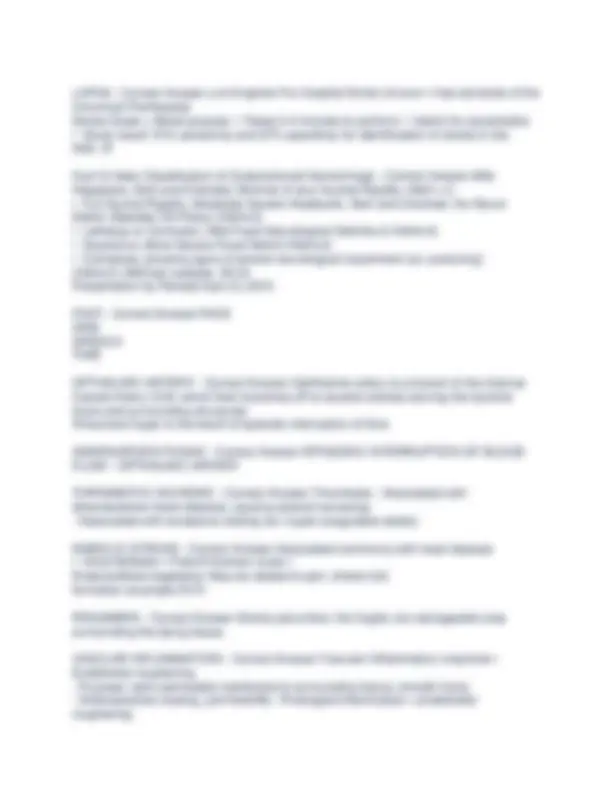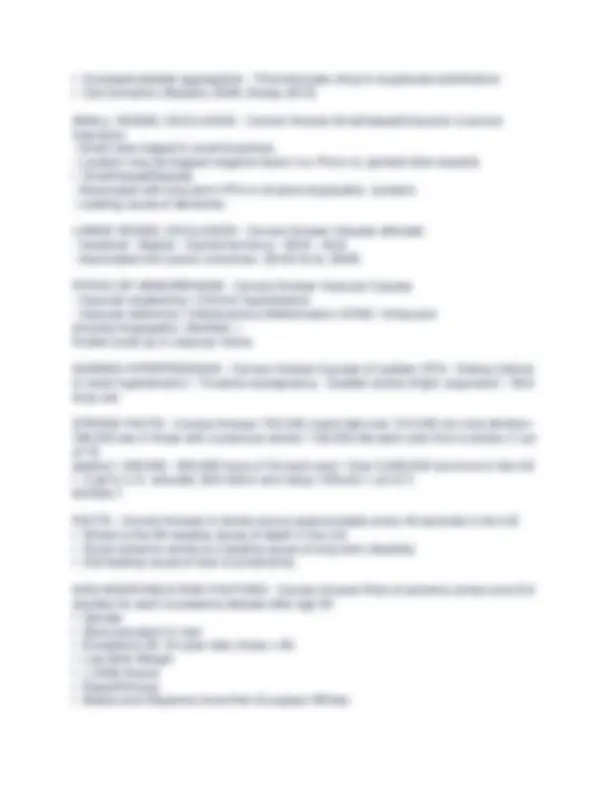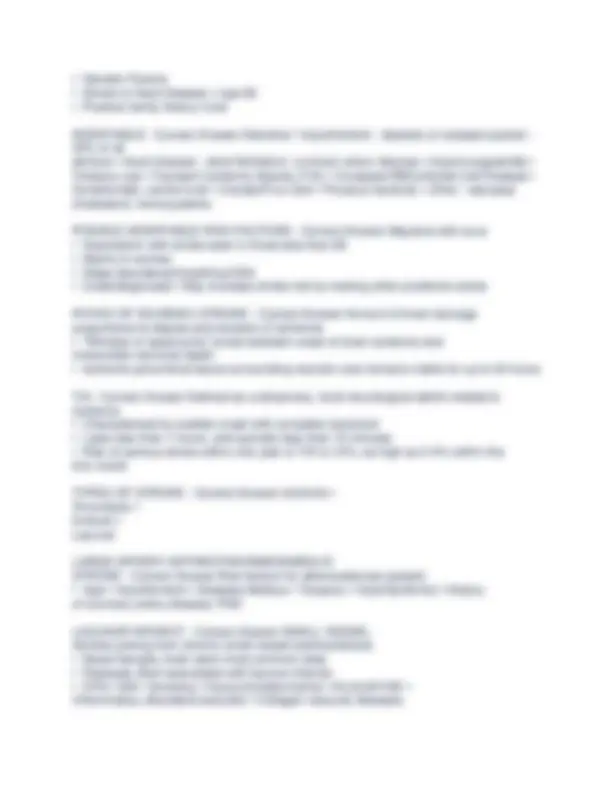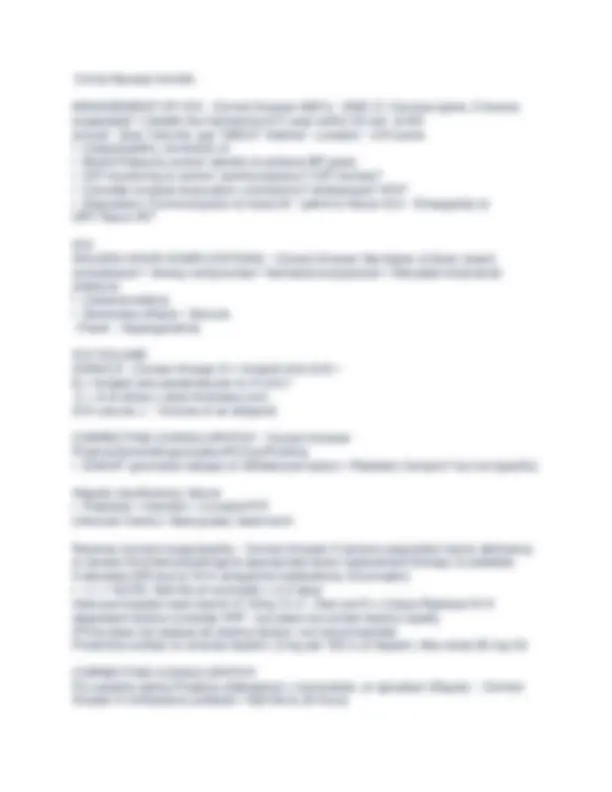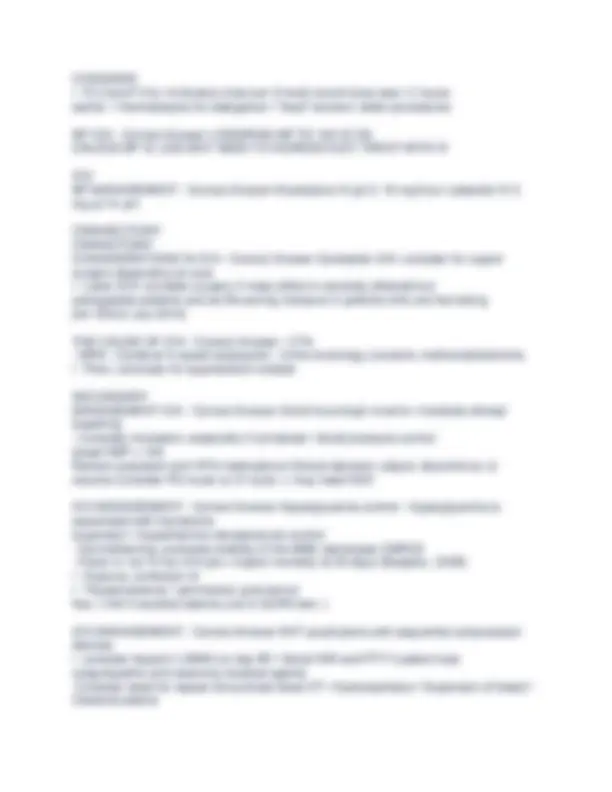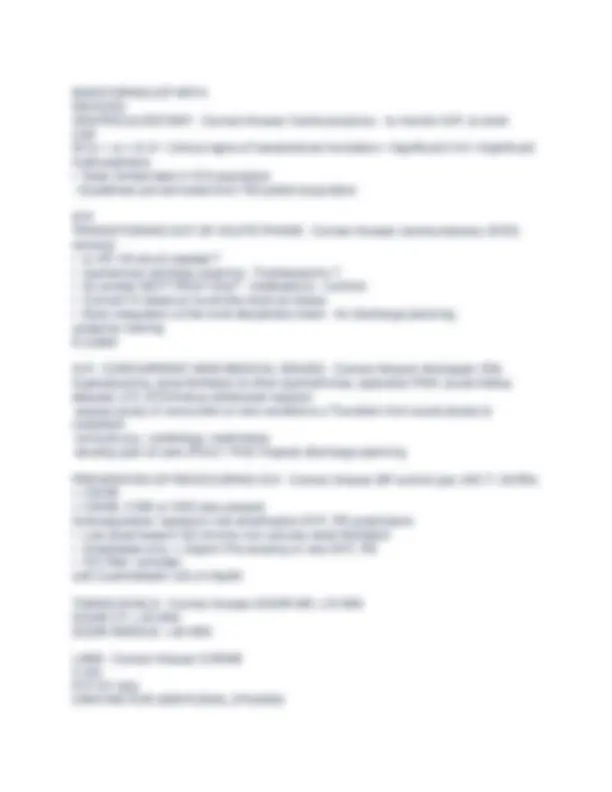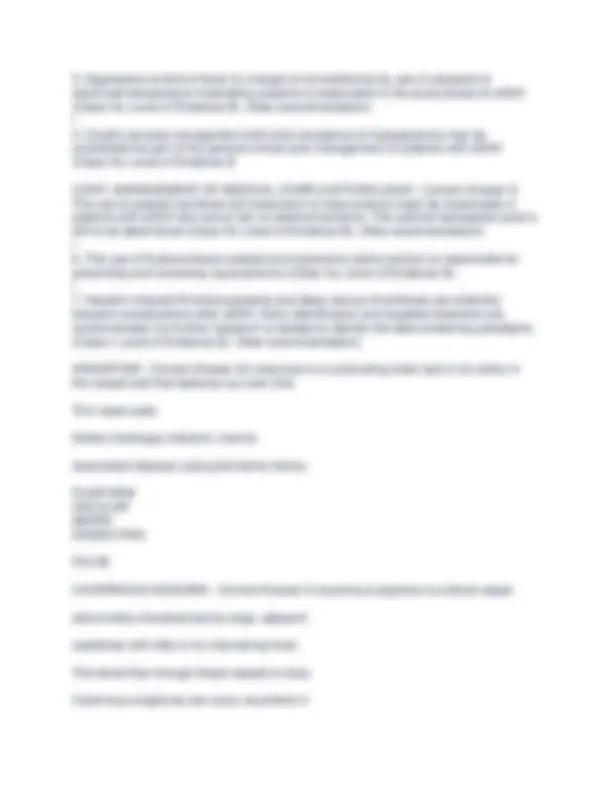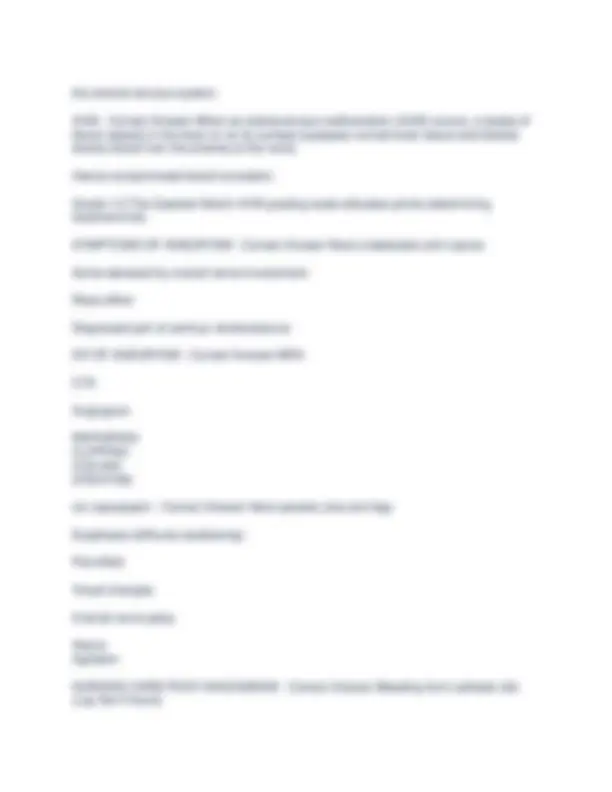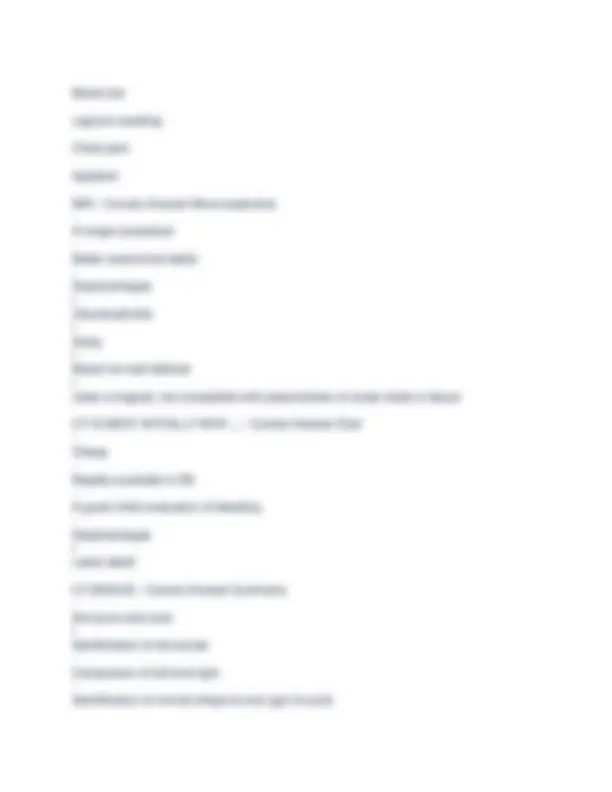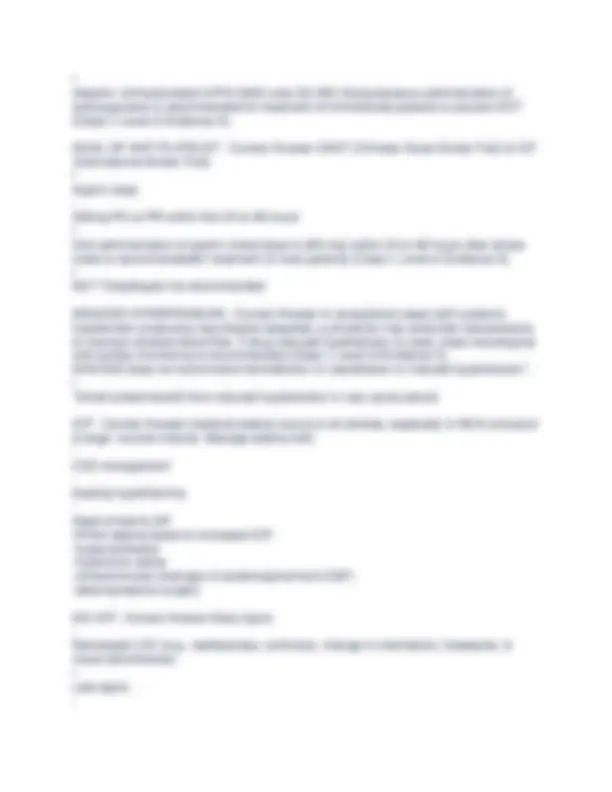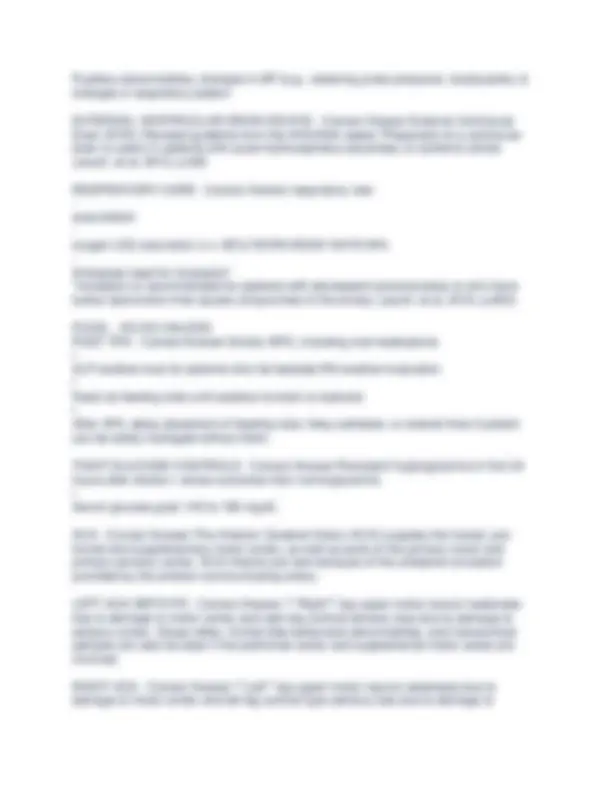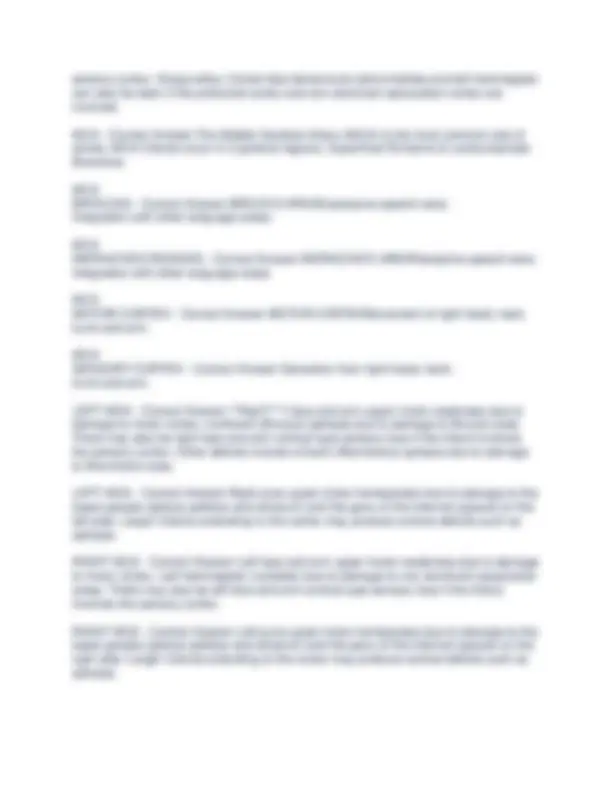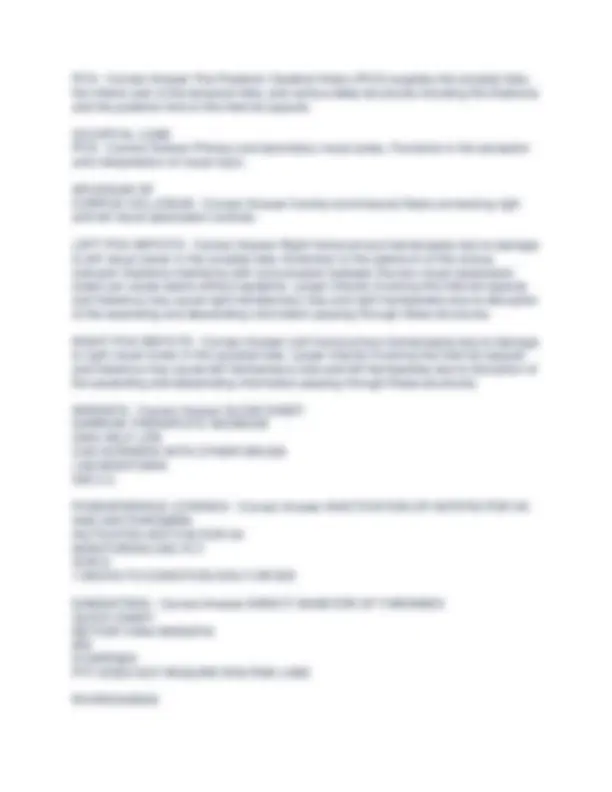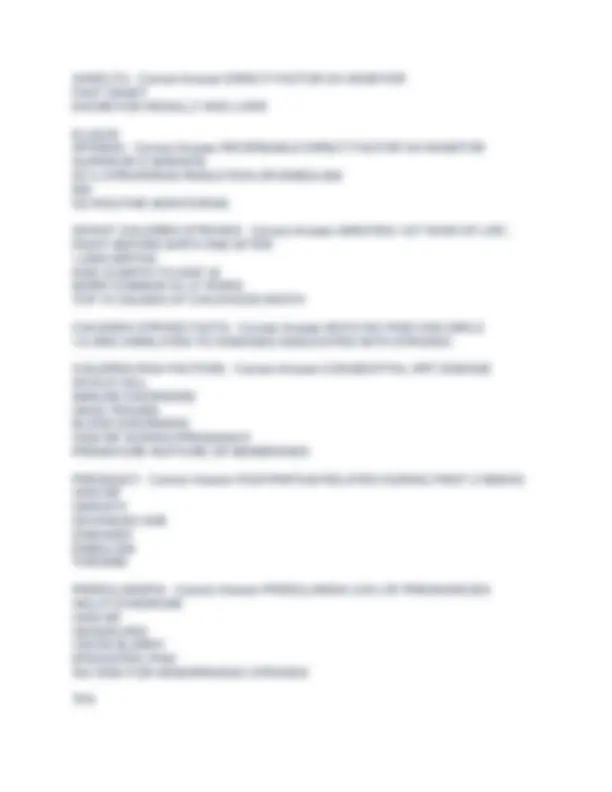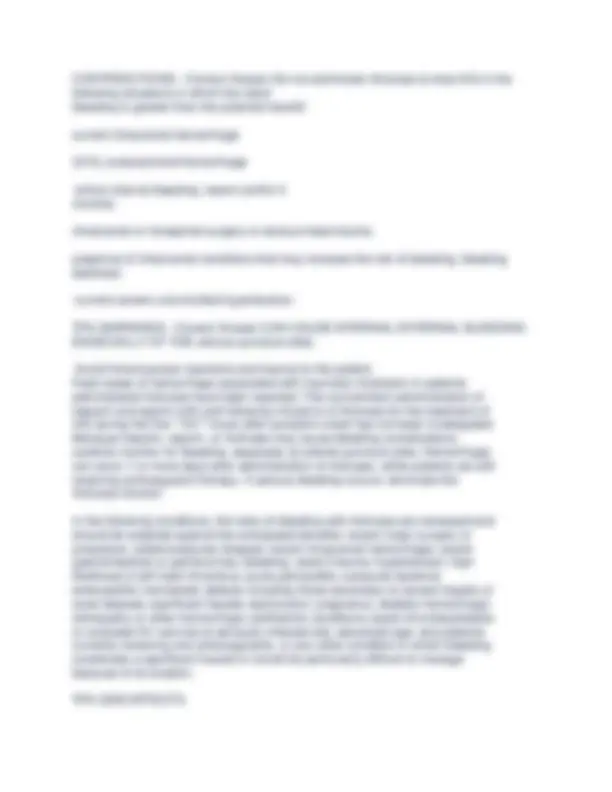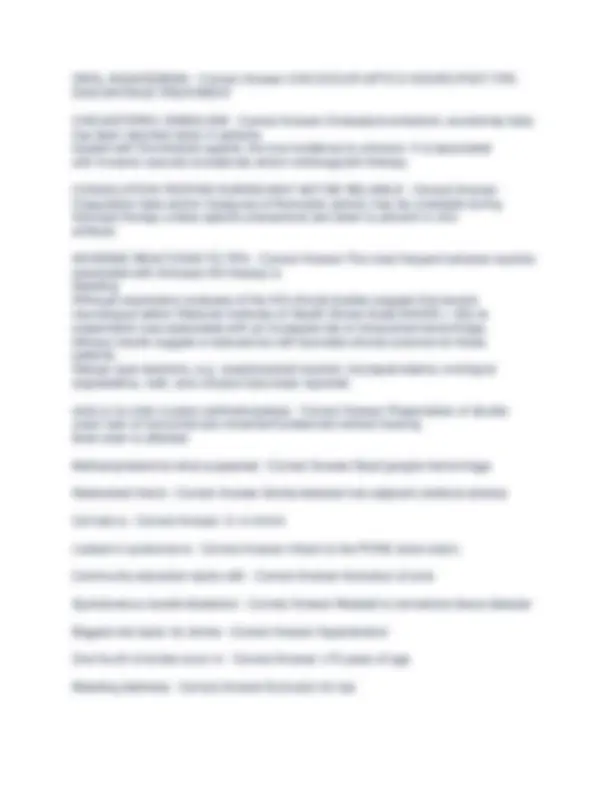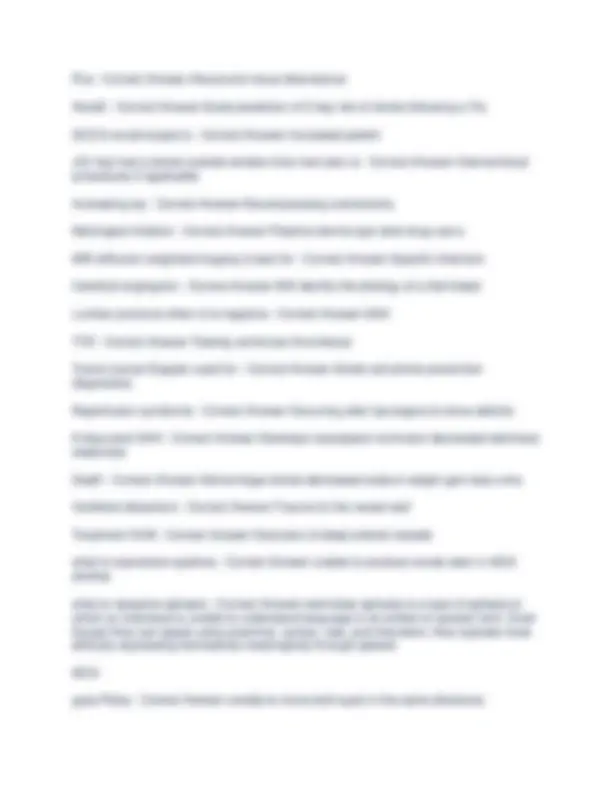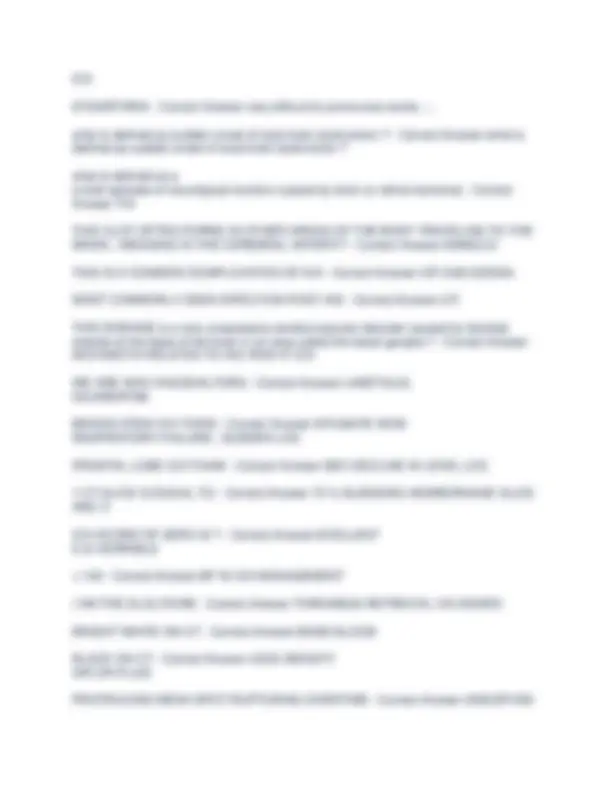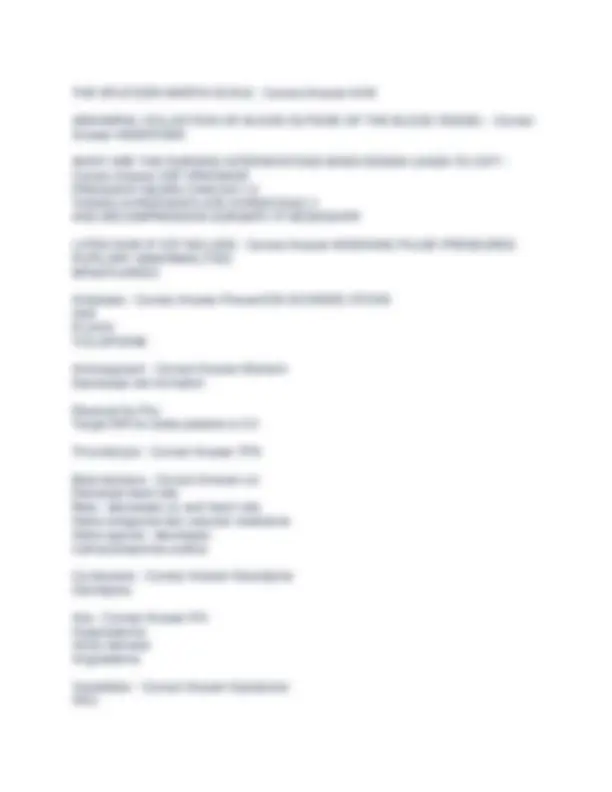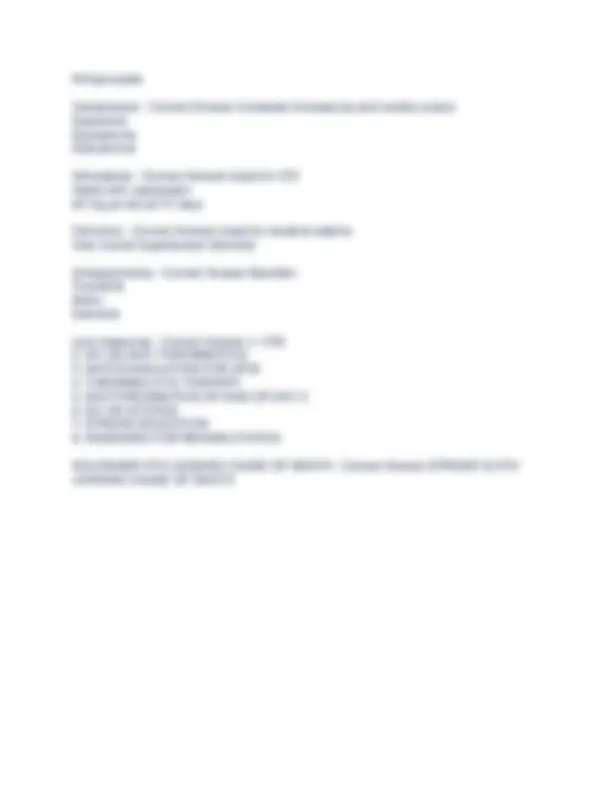Download Stroke Management and Pathophysiology and more Exams Nursing in PDF only on Docsity!
SCRN Exam
100% Correct Answers 2024
BARTHEL INDEX - Correct Answer-Barthel Index
- This evaluation is a measure of functional ability to manage ADL's and degree of help needed.
- Feeding
- Bathing
- Grooming
- Dressing
- Bowel - Bladder - Toileting - Transfers - Stairs
- Mobility • Mahoney FI, Barthel D. "Functional evaluation: the Barthel Index.Maryland RANKIN SCORE - Correct Answer-Originally used as an interview (Rankin)
- Modified for clinical use (mRankin)
- Commonly used as an outcome point in research due to ease of application
- 0 - No symptoms. • 1 - No significant disability. Able to carry out all usual activities, despite some symptoms. • 2 - Slight disability. Able to look after own affairs without assistance, but unable to carry out all previous activities.
- 3 - Moderate disability. Requires some help, but able to walk unassisted.
- 4 - Moderately severe disability. Unable to attend to own bodily needs without assistance, and unable to walk unassisted.
- 5 - Severe disability. Requires constant nursing care and attention, bedridden, incontinent.
- 6 - Dead FIM FUNCTIONAL INDEPENDANCE MEASURE - Correct Answer-The motor subscale includes: • Eating • Grooming • Bathing
- Dressing, upper body • Dressing, lower body • Toileting • Bladder management
- Bowel management
- Transfers - bed/chair/wheelchair • Transfers - toilet • Transfers - bath/shower
- Walk/wheelchair
- Stairs The cognition subscale includes:
- Comprehension
- Expression Unique Presentation by Pamela Nye (C) 2015
- Social interaction • Problem solving • Memory SOCRING FIM - Correct Answer-Each item is scored on a 7 point ordinal scale, ranging from a score of 1 to a score of 7. The higher the score, the more independent the patient is in performing the task associated with that item.
- 1 - Total assistance with helper • 2 - Maximalassistancewithhelper • 3 - Moderate assistance with helper • 4 - Minimal assistance with helper • • • 5 - Supervision or setup with helper 6 - Modified independence with no helper 7 - Complete independence with no helper GCS SCALE - Correct Answer-BEST EYE RESPONSE 4 SPONTANEOUS TO BLINKING 3 OPENS TO VERBAL COMMNAD SHOUTING 2 OPENS TO PAIN 1 NONE BEST VERBAL 1ORIENTED 2CONFUSED 3INAPPROTIRATE SLURRED 4INCOMPREHENSAB;E 5NONE BEST MOTOR 1 OBEYS COMMANDS 2 PURPOUSEFUL MOTOR MOVEMENTS 3WITHDRAWS FROM STIMULI 4ABNORMAL FLEXION , POSTURING 6RIGID DECERABATE POSTURE 6NONE NIH SCORE - Correct Answer-Level of Conscious • Orientation (age/month) • Vision • Best Motor (4 limbs) • Sensory • Best Language Follows Commands Best Gaze Facial Palsy Limb Ataxia Neglect/Extinction Dysarthria WORST 42 BEST 0
- Increased platelet aggregation - Thrombocytes cling to roughened endothelium
- Clot formation (Roberts, 2009; Hickey 2010) SMALL VESSEL OCCLUSION - Correct Answer-SmallVesselOcclusion (Lacunar Infarction)
- Small clots lodged in small branches.
- Location may be biggest negative factor (i.e. Pons vs. parietal lobe vessels)
- SmallVesselDisease
- Associated with long term HTN or amyloid angiopathy. (protein)
- Leading cause of dementia. LARGE VESSEL OCCLUSION - Correct Answer-Vessels affected:
- Vertebral - Basilar - Carotid terminus - MCA - ACA
- Associated with poorer outcomes. (Smith et al, 2009) PATHO OF HEMORRHAGE - Correct Answer-Vascular Causes
- Vascular weakening • Chronic hypertension
- Vascular deformity • Arteriovenous Malformation (AVM) • Aneurysm Amyloid Angiopathy: (familial)→ Protein build-up in vascular intima SUDDEN HYPERTENSION - Correct Answer-Causes of sudden HTN - Kidney (failure or renal hypertension) - Toxemia w/pregnancy - Sudden stress (fright, argument) - Illicit drug use STROKE FACTS - Correct Answer-795,000 cases last year; 610,000 are new strokes • 185,000 are in those with a previous stroke • 130,000 die each year from a stroke (1 out of 19 deaths) • 200,000 - 500,000 have a TIA each year • Over 3,000,000 survivors in the US
- Cost to U.S. annually: $54 billion and rising • Affects 1 out of 5 families 1 FACTS - Correct Answer-A stroke occurs approximately every 40 seconds in the US
- Stroke is the 5th leading cause of death in the US
- Acute ischemic stroke is a leading cause of long-term disability
- 2nd leading cause of loss of productivity NON MODIFIABLE RISK FACTORS - Correct Answer-Risk of ischemic stroke and ICH doubles for each successive decade after age 55
- Gender
- More prevalent in men
- Exceptions 35 - 44 year olds; those > 85
- Low Birth Weight
- < 2500 Grams
- Race/Ethnicity
- Blacks and Hispanics more than European Whites
- Genetic Factors
- Stroke or heart disease < age 60
- Positive family history incre MODIFIABLE - Correct Answer-Diabetes • Hypertension - diastolic or isolated systolic - 40% of all strokes • Heart disease - atrial fibrillation, coronary artery disease • Hypercoagulability • Tobacco use • Transient Ischemic Attacks (TIA) • Increased RBCs/Sickle Cell Disease • Symptomatic carotid bruit • Obesity/Poor Diet • Physical inactivity • Other - elevated cholesterol, homocysteine POSIBLE MODIFIABLE RISK FACTORS - Correct Answer-Migraine with aura
- Association with stroke seen in those less than 60
- Mainly in women
- Sleep disordered breathing/OSA
- Underdiagnosed • May increase stroke risk by making other problems worse PATHO OF ISCHEMIC STROKE - Correct Answer-Amount of brain damage proportional to degree and duration of ischemia
- "Window of opportunity" exists between onset of brain ischemia and irreversible neuronal death
- Ischemic penumbral tissue surrounding necrotic core remains viable for up to 24 hours TIA - Correct Answer-Defined as a temporary, focal neurological deficit related to ischemia
- Characterized by sudden onset with complete resolution
- Lasts less than 1 hours, and typically less than 10 minutes
- Risk of serious stroke within one year of TIA is 10%; as high as 2 - 5% within the first month TYPES OF STROKE - Correct Answer-Ischemic • Thrombotic • Embolic • Lacunar LARGE ARTERY ARTHROTRHOMBOEMBOLIC STROKE - Correct Answer-Risk factors for atherosclerosis present
- Age • Hypertension • Diabetes Mellitus • Tobacco • Hyperlipidemia • History of coronary artery disease, PAD LACUNAR INFARCT - Correct Answer-SMALL VESSEL Strokes arising from chronic small vessel arteriosclerosis
- Basal Ganglia, brain stem most common sites
- Diseases often associated with lacunar infarcts:
- HTN • DM • Smoking • Hypercholesterolemia • Alcohol/IVDA • Inflammatory disorders/vasculitis • Collagen vascular diseases
LESS COMMON
MOYA MOYA
Mycotic aneurysm Vasculitis Berry aneurysm NON MODIFIABLE RISK ICH - Correct Answer-Age - Risk increases with every 10 - year increase in age
- Gender: men > women • Race: higher incidence in:
- Asians, Blacks, Mexicans • Genetics:
- apolipoprotein (APOE): є2, є4 - > may contribute to development of CAA
- Inherited disorders of clotting factors [Ref.: AANN 2014] ICH TREATING MODIFAIBLE RISK FACTORS - Correct Answer-HTN Maintain BP goal [SCRN text uses JNC 7 guidelines; see JNC 8 guidelines ] ETOH use (excessive) Prevention strategies: e.g. coping skills ETOH recovery/rehab Coagulopathy due to medications (warfarin, Plavix, ASA, apixaban) Evaluate risk:benefit ratio of anticoag Rx Education: prevention of falls & head trauma Monitor doses, compliance Coagulopathy due to other medical condition (e.g., cirrhosis; ITP) Treat & manage the underlying disease Prevent falls & head trauma Sympathomimetic drugs (cocaine, methamphetamine, ephedrine) Drug abuse rehab/ cessation Weight loss strategies other than drugs Educate: excessive use of cold/flu OTC meds Previous ICH & non-valvular atrial fibAnticoagulation not recommended Hemorrhagic transformation of ischemic stroke Adhere to tPA dosing guidelines BP control Reperfusion syndrome (after stenting; Monitor w/ TCD tPA therapy; CEA) BP control w/ non-vasodilators ,e .g. labetalol, ICH S/S - Correct Answer-Sgns/ symptoms that suggest ICH but are not specific to ICH: Severe headache Onset: minutes to hours rather than "suddenly" o Due to expansion of the hemorrhage Acute severe HTN (SBP >220) as initial vital sign Decreased level of consciousness progressing to coma for deep ICH: rapid loss of consciousness
Coma Nausea Vomitin MANAGEMENT OF ICH - Correct Answer-ABC's - [ABC-C: Cervical spine, if trauma suspected] • Classify the hematoma [CT scan within 25 min. of ED arrival] - Size/ Volume: use "ABC/2" method - Location - ICH score
- Coagulopathy, correction of
- Blood Pressure control: identify & achieve BP goals
- ICP monitoring & control: ventriculostomy? ICP monitor?
- Consider surgical evacuation: craniotomy? endoscopic? tPA?
- Disposition: Communication & hand-off - admit to Neuro ICU - Emergently to OR? Neuro IR? ICH GOLDEN HOUR COMPLICATIONS - Correct Answer-Herniation & Brain (stem) compression • Airway compromise • Hematoma expansion • Elevated intracranial pressure
- Cerebral edema
- Secondary effects - Seizure
- Fever - Hypergylcemia ICH VOLUME AXBXC/2 - Correct Answer-A = longest axis (cm) • B = longest axis perpendicular to A (cm) • C = # of slices x slice thickness (cm) ICH volume = ~ Volume of an ellipsoid CORRECTING COAGULOPATHY - Correct Answer- Prothrombinclottingcomplex(PCC)orProfiline
- DDAVP (promotes release of vWillebrand factor) • Platelets ("empiric" but not specific) Hepatic insufficiency/ failure
- Platelets • VitaminK • ConsiderFFP Unknown history • Best guess; least harm Reverse /correct coagulopathy - Correct Answer-If severe coagulation factor deficiency or severe thrombocytopeniagive appropriate factor replacement therapy or platelets If elevated INR due to Vit K antagonist medications (Coumadin):
- • • • • NOTE: Half-life of coumadin-> 4 - 5 days Hold pre-hospital med vitamin K 10mg IV x1 , then po/IV x 3 days Replace Vit K dependent factors Consider FFP - but does not correct factors rapidly rFVIIa does not replace all clotting factors - not recommended Protamine sulfate: to reverse heparin. [1mg per 100 U of heparin. Max dose 50 mg IV] CORRECTING COAGULOPATHY For patients taking Pradaxa (dabigatran), rivaroxaban, or apixaban (Elquis): - Correct Answer-X inhibitorsno antidote • Half-life is 24 hours
MONITORING ICP WITH
DEVICES
VENTRICULOSTOMY - Correct Answer-Ventriculostomy - to monitor ICP, to drain CSF GCS < or = to 8 • Clinical signs of transtentorial herniation • Significant IVH • Significant hydrocephalus
- Note: limited data in ICH population
- Guidelines are borrowed from TBI patient population ICH TRANSITIONING OUT OF ACUTE PHASE - Correct Answer-ventriculostomy (EVD) removal
- Is VP/ VA shunt needed?
- mechanical ventilator weaning - Tracheostomy?
- GI access NGT? PEG? Oral? - medications - nutrition
- Convert IV doses to round-the-clock po doses
- Early integration of the multi-disciplinary team - for discharge planning, caregiver training E.Cattell ICH - CONCURRANT NEW MEDICAL ISSUES - Correct Answer-Anticipate: DM, hyperglycemia, atrial fibrillation & other dysrhythmias, aspiration PNA, acute kidney disease, UTI, ETOH/drug withdrawal reaction assess acuity of concurrent or new conditions o Transition from acute phase to outpatient consults e.g., cardiology, nephrology develop plan of care (POC) • POC impacts discharge planning PREVENTION OF REOCCURING ICH - Correct Answer-BP control (per JNC 7; SCRN) < 140/ < 130/80, if DM or CKD also present Anticoagulation: based on risk stratification DVT, PE prophylaxis
- Low dose heparin SC chronic non-valvular atrial fibrillation
- Antiplatelet only - > Aspirin Pre-existing or new DVT, PE
- IVC filter; consider coE.Cuatmtelladin UCLA Health TIMING GOALS - Correct Answer-DOOR MD <10 MIN DOOR CT < 25 MIN DOOR NEEDLE < 60 MIN LABS - Correct Answer-CHEM 2 IVS PTT PT ING CRATINE FOR ADDITIONAL STUDIES
CTA
TPA ADMINISTRTION - Correct Answer-CONSENT NIHSS BEFORE ADMINISTRATION DOSE 0.9 MG/KG X 2 RN DISCARD WASTE 10% BOLUS OVER 1 MIN. WEIGHT BASED OVER 1 HR VITAL SIGNS - Correct Answer-WITH NIHSS SCALE Q 15 X Q 30 MIN X 6 HRS Q 1 HR X 16 HRS BEDSIDE SWALLOW SCREEN A MUST BEFORE ANY PO TARGET STROKE BEST STRATEGIES - Correct Answer-1.EMS Pre-Notification 2.Stroke Toolkit 3.Rapid Triage and Stroke Team Notification 4.Single Call Activation System 5.Transfer Directly to CT 6.Rapid Brain Imaging 7.POC Laboratory Testing 8.Premix TPA 9.Rapid TPA Access - store TPA in ED/radiology, start in imaging suite 10.Team approach 11.*Prompt data feedback CONTROLLING BLOOD PRESSURE - Correct Answer-BP control for >185/ »Labetalol 10 - 20 mg IV over 1 - 2 minutes, may repeat 1 time; or »Nicardipine 5 mg/h IV, titrate up by 2.5 mg/h every 5-15 minutes, maximum 15 mg/h; or »Other agents (hydralazine, enalaprilat, etc) may be considered when appropriate COMPREHENSIVE STROKE CENTER - Correct Answer-Comprehensive Stroke Centers --Able to care for complex patients --Advanced treatments (i.e. coils, stents, IA recanalization, etc) --Trained specialists in key areas (Vascular neurology, Neurointerventional procedures, Neurocritical Care, Vascular Neurosurgery APHASIA - Correct Answer-Aphasia: is the loss of ability to produce and/or understand language. This usually manifests as a difficulty speaking or understanding spoken language but reading and writing are also usually impacted.
- Aggressive control of fever to a target of normothermia by use of standard or advanced temperature modulating systems is reasonable in the acute phase of aSAH (Class IIa; Level of Evidence B). (New recommendation)
- Careful glucose management with strict avoidance of hypoglycemia may be considered as part of the general critical care management of patients with aSAH (Class IIb; Level of Evidence B CONT. MANAGEMENT OF MEDICAL COMPLICATIONS aSAH - Correct Answer-5. The use of packed red blood cell transfusion to treat anemia might be reasonable in patients with aSAH who are at risk of cerebral ischemia. The optimal hemoglobin goal is still to be determined (Class IIb; Level of Evidence B). (New recommendation)
- The use of fludrocortisone acetate and hypertonic saline solution is reasonable for preventing and correcting hyponatremia (Class IIa; Level of Evidence B).
- Heparin-induced thrombocytopenia and deep venous thrombosis are relatively frequent complications after aSAH. Early identification and targeted treatment are recommended, but further research is needed to identify the ideal screening paradigms (Class I; Level of Evidence B). (New recommendation) ANEURYSM - Correct Answer-An aneurysm is a protruding weak spot in an artery in the vessel wall that balloons out over time Thin weak walls Defect; blockage; infection; trauma Associated disease: polycystic/family history FUSIFORM SACULAR BERRY DISSECTING FALSE CAVERNOUS ANGIOMA - Correct Answer-A cavernous angioma is a blood vessel abnormality characterized by large, adjacent capillaries with little or no intervening brain. The blood flow through these vessels is slow. Cavernous angiomas can occur anywhere in
the central nervous system. AVM - Correct Answer-When an arteriovenous malformation (AVM) occurs, a tangle of blood vessels in the brain or on its surface bypasses normal brain tissue and directly diverts blood from the arteries to the veins. Hence compromised blood circulation. Grade 1-5 The Spetzler-Martin AVM grading scale allocates points determining treatment/risk. SYMPTOMS OF ANEURYSM - Correct Answer-Most undetected until rupture Some declared by cranial nerve involvement Mass effect Diagnosed part of workup: stroke/seizure DX OF ANEURYSM - Correct Answer-MRA CTA Angiogram REPAIRING CLIPPING COILING STENTING s/s vasospasm - Correct Answer-Hemi paresis (one arm/leg) Dysphasia (difficulty swallowing) Flat affect Visual changes Cranial nerve palsy Ataxia Agitation NURSING CARE POST ANGIOGRAM - Correct Answer-Bleeding form catheter site (Lay flat 4 hours)
Identification of pathology
CT White=↑density (bone, blood)
CT Black=↓density (air, fluid)
Measurement
Shift of the falx ±5mm is significant
Hemorrhage: length x width x height (how many cuts?)
Average number of cuts on brain CT? 5 - 10mm MRA - Correct Answer-Uses a magnet, same risks with metal
Less invasive
Can be with/without contrast media
Takes 30 - 60 min. to complete
Turbulent flow may cause artifact (aneurysm) ANGIOGRAM - Correct Answer-Angiogram
Femoral artery access needed.
Risk of dye allergies
Shellfish, iodine
Better visualization of occlusion & aneurysm (physician opinion)
More invasive
Allows coiling with catheter already being used. (aneurysm) ICU CARE - Correct Answer-ADMIT TO ICU < 3 HRS POST TREATMENT 25% of pts with ischemic stroke will deteriorate clinically in first 1 - 2 days.
Pts with ICH or SAH at risk for deterioration 2/2 hemorrhagic expansion, edema progression, & hernation GOAL OF ICU TREATMENT - Correct Answer-1)
Close observation for changes in patient's condition
Observation & treatment to reduce bleeding after IV rtPA
Facilitate measures to improve outcomes after stroke
Begin measures to prevent subacute complications
Initiate long-term therapies to prevent recurrent stroke
Start efforts to restore neurological function BLOOD PRESSURE ICU TREATMENT - Correct Answer-Maintain SBP <
Hypertension-> encephalopathy, cardiac complications, & renal insufficiency
Hypotension-> decreased perfusion to organs, especially ischemic brain
Ideal blood pressure range not scientifically determined
After rtPA, keep BP<180/110 to reduce ICH risk BP MEDICATIONS - Correct Answer-Labetalol IV push 10 - 20mg, may repeat x 1
Nicardipine gtt 5 - 15mg/hr
Nipride? **NO NO NO ** Causes vasodilation & may increase cerebral ischemia (Pugh, et al, 2008, p. 18) FLUID CONTROL ISCHEMIC STROKE - Correct Answer-Goal: Euvolemia
Hypovolemia-> hypo-perfusion-> ischemic brain injury, renal impairment & thrombosis.
Hypervolemia-> exacerbate ischemic brain edema & increase cardiac workload
1st choice: Isotonic saline (0.9% NaCl) 75 - 100 CC /HR Avoid: D5 & 0.45% NaCl ANTICOAGULANT GOALS - Correct Answer-Stop neurological worsening
Prevent early re-embolization
Improve neurological outcomes
***No anticoagulation or antiplatelet within 24 hours of rtPA.
Pupillary abnormalities, changes in BP (e.g., widening pulse pressure), bradycardia, & changes in respiratory pattern EXTERNAL VENTRICULAR DRAIN DEVICE - Correct Answer-External Ventricular Drain (EVD): Revised guideline from the AHA/ASA states "Placement of a ventricular drain is useful in patients with acute hydrocephalus secondary to ischemic stroke (Jauch, et al, 2013, p. RESPIRATORY CARE - Correct Answer-respiratory rate
auscultation
oxygen (O2) saturation (>/= 92%)*SCRN BOOK SAYS 94%
Anticipate need for intubation* *Intubation is recommended for patients with decreased consciousness or who have bulbar dysfunction that causes compromise of the airway (Jauch, et al, 2013, p.893) FOOD. .. NO NO UNLESS POST TPA - Correct Answer-Strictly NPO, including oral medications
SLP swallow eval for patients who fail bedside RN swallow evaluation
Feed via feeding tube until swallow function is restored
After rtPA, delay placement of feeding tube, foley catheters, or arterial lines if patient can be safely managed without them. TIGHT GLUCOSE CONTROLS - Correct Answer-Persistent hyperglycemia in first 24 hours after stroke-> worse outcomes than normoglycemia.
Serum glucose goal: 140 to 180 mg/dL ACA - Correct Answer-The Anterior Cerebral Artery (ACA) supplies the frontal, pre- frontal and supplementary motor cortex, as well as parts of the primary motor and primary sensory cortex. ACA infarcts are rare because of the collateral circulation provided by the anterior communicating artery. LEFT ACA DEFICITS - Correct Answer-Right leg upper-motor neuron weakness due to damage to motor cortex and right leg cortical sensory loss due to damage to sensory cortex. Grasp reflex, frontal lobe behavioral abnormalities, and transcortical aphasia can also be seen if the prefrontal cortex and supplemental motor areas are involved. RIGHT ACA - Correct Answer-Left* leg upper-motor neuron weakness due to damage to motor cortex and left leg cortical type sensory loss due to damage to
sensory cortex. Grasp reflex, frontal lobe behavioural abnormalities and left hemineglect can also be seen if the prefrontal cortex and non-dominant association cortex are involved. MCA - Correct Answer-The Middle Cerebral Artery (MCA) is the most common site of stroke. MCA infarcts occur in 2 general regions: Superficial Divisions & Lenticulostriate Branches. MCA BROCCAS - Correct Answer-BROCA'S AREAExpressive speech area. Integration with other language areas. MCA WERNICKES REGIONS - Correct Answer-WERNICKE'S AREAReceptive speech area. Integration with other language areas MCA MOTOR CORTEX - Correct Answer-MOTOR CORTEXMovement of right head, neck, trunk and arm. MCA SENSORT CORTEX - Correct Answer-Sensation from right head, neck, trunk and arm. LEFT MCA - Correct Answer-RighT*t face and arm upper-motor weakness due to damage to motor cortex, nonfluent (Broca's) aphasia due to damage to Broca's area. There may also be right face and arm cortical type sensory loss if the infarct involves the sensory cortex. Other deficits include a fluent (Wernicke's) aphasia due to damage to Wernicke's area. LEFT MCA - Correct Answer-Right pure upper-motor hemiparesis due to damage to the basal ganglia (globus pallidus and striatum) and the genu of the internal capsule on the left side. Larger infarcts extending to the cortex may produce cortical deficits such as aphasia. RIGHT MCA - Correct Answer-Left face and arm upper-motor weakness due to damage to motor cortex. Left hemineglect (variable) due to damage to non-dominant association areas. There may also be left face and arm cortical type sensory loss if the infarct involves the sensory cortex. RIGHT MCA - Correct Answer-Left pure upper-motor hemiparesis due to damage to the basal ganglia (globus pallidus and striatum) and the genu of the internal capsule on the right side. Larger infarcts extending to the cortex may produce cortical deficits such as aphasia.

